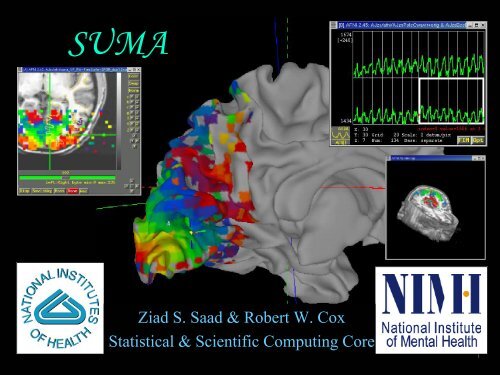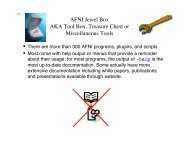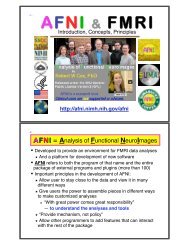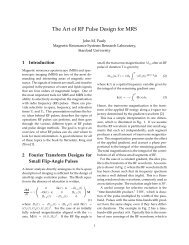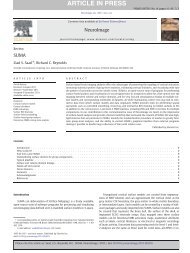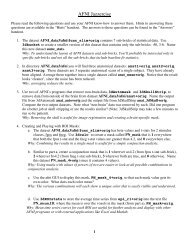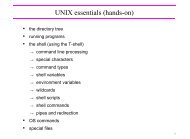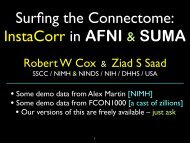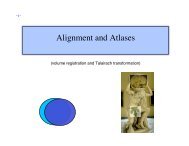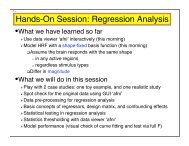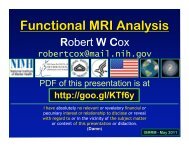SUMA - the AFNI/NIfTI Server
SUMA - the AFNI/NIfTI Server
SUMA - the AFNI/NIfTI Server
You also want an ePaper? Increase the reach of your titles
YUMPU automatically turns print PDFs into web optimized ePapers that Google loves.
<strong>SUMA</strong><br />
Ziad S. Saad & Robert W. Cox<br />
Statistical & Scientific Computing Core
SSCC 4/25/03
SSCC 4/25/03
SSCC 4/25/03
<strong>SUMA</strong><br />
SSCC 4/25/03
SUrface MApping with <strong>AFNI</strong><br />
• Surface mapping & viewing program tightly<br />
linked to <strong>AFNI</strong><br />
• Complements <strong>AFNI</strong>’s slice and volume rendering<br />
modes<br />
• Provides a framework for fast and usercustomizable<br />
surface based analysis<br />
• Supports surface models created by:<br />
FreeSurfer http://surfer.nmr.mgh.harvard.edu<br />
SureFit/Caret http://stp.wustl.edu/resources/display.html<br />
BrainVoyager http://www.brainvoyager.com<br />
• Allows representation of sparsely defined 3D data<br />
SSCC 4/25/03
System Requirements<br />
MESA Library 4.0.1 (an API closely resembling OpenGL)<br />
http://www.mesa3d.org/<br />
• Currently Running On:<br />
– Pentium IV, 1.9 Ghz / Linux<br />
–1Gb RAM<br />
– nVIDIA GeForce4 graphics card 64 Mb<br />
• Also Runs On:<br />
–SGI<br />
– SUN with openGL 1.2 or newer<br />
– Mac OSX with Xfree86, Motif and Mesa<br />
SSCC 4/25/03
Installation<br />
• Binaries for <strong>SUMA</strong> are available from:<br />
http://afni.nimh.nih.gov/ssc/ziad/<strong>SUMA</strong>/<strong>SUMA</strong>_DownloadTable.htm<br />
• On some machines (i.e. Linux), <strong>SUMA</strong> should be<br />
compiled locally for optimal performance.<br />
• To compile <strong>SUMA</strong> you need to have:<br />
– Motif (both libraries and header files)<br />
– Mesa (OpenGL)<br />
– <strong>AFNI</strong>’s source code distribution<br />
• Detailed installation info for various systems:<br />
http://afni.nimh.nih.gov/ssc/ziad/<strong>SUMA</strong>/<strong>SUMA</strong>_Installation.htm<br />
SSCC 4/25/03
Where do Surface Models Come From ?<br />
• For surface based analysis:<br />
– Must create surfaces for individual subjects<br />
– Pre<strong>SUMA</strong>:<br />
• Collect, align and average high-quality, high-resolution anatomical data<br />
– On NIMH’s 3T-1, 4 MPRAGE data sets will do<br />
• Correct image non-uniformity<br />
– Using <strong>AFNI</strong>’s 3dUniformize or <strong>the</strong> N3 normalization tool [J.G. Sled et al. 98]<br />
• Create and correct surfaces<br />
– Using FreeSurfer, SureFit or BrainVoyager<br />
– Circum<strong>SUMA</strong>:<br />
• Align surface with experimental data<br />
– Using @<strong>SUMA</strong>_AlignToExperiment<br />
• Map experimental volumetric data to surface<br />
– Using <strong>AFNI</strong> and <strong>SUMA</strong><br />
– Post<strong>SUMA</strong>:<br />
• Fame, Fortune and Fortitude for some, if not all, or none of you<br />
• For display (mostly) of Talairach data:<br />
– Use <strong>the</strong> Talairach surfaces created from <strong>the</strong> N27 brain data set using<br />
FreeSurfer.<br />
• Ready to use, no surface creation or alignment needed.<br />
SSCC 4/25/03
A: Preparing Surface Models for <strong>SUMA</strong><br />
High-Res.<br />
Anatomical<br />
MRI data<br />
Create Surface<br />
Models<br />
(FreeSurfer,<br />
SureFit, etc.)<br />
@<strong>SUMA</strong>_Make_Spec_FS<br />
@<strong>SUMA</strong>_Make_Spec_SF<br />
SurfVol<br />
<strong>AFNI</strong>-format Surface Volume<br />
that is aligned with surface<br />
models<br />
Spec File<br />
ASCII file defining<br />
relationships between<br />
different surfaces<br />
SSCC 4/25/03
A: Preparing Surface Models for <strong>SUMA</strong><br />
• Create <strong>the</strong> Surface Volume<br />
– SurfVol is an <strong>AFNI</strong> data set created from data used to create <strong>the</strong> surfaces.<br />
• Create <strong>the</strong> surface specifications (spec) file<br />
– The Spec file defines <strong>the</strong> relationships between <strong>the</strong> different surfaces.<br />
• Both <strong>the</strong> surface volume and <strong>the</strong> Spec file are created automatically<br />
– Using @<strong>SUMA</strong>_Make_Spec_FS for FreeSurfer surfaces<br />
– Using @<strong>SUMA</strong>_Make_Spec_SF for SureFit surfaces<br />
• Demo for FreeSurfer surfaces:<br />
– cd suma_demo/SurfData<br />
• This is where FreeSurfer’s directories reside<br />
– @<strong>SUMA</strong>_Make_Spec_FS -sid DemoSubj<br />
• Creates <strong>the</strong> SurfVol from <strong>the</strong> .COR files<br />
– DemoSubj_SurfVol+orig<br />
• Creates ASCII versions of surfaces found in <strong>the</strong> surf directory<br />
– lh*.asc and rh*.asc (if rh surfaces are provided)<br />
• Creates he Spec files for <strong>the</strong> left and right hemisphere surfaces<br />
– DemoSubj_lh.spec and DemoSubj_rh.spec (if rh surfaces are provided)<br />
– cd <strong>SUMA</strong><br />
– afni –niml &<br />
• launches <strong>AFNI</strong> to allow <strong>the</strong> viewing of DemoSubj_lh.spec<br />
• <strong>the</strong> –niml option tells <strong>AFNI</strong> to listen to connections from <strong>SUMA</strong><br />
– suma –spec DemoSubj_lh.spec –sv DemoSubj_SurfVol+orig<br />
SSCC 4/25/03
Check For Proper Alignment and Defects<br />
• With both <strong>SUMA</strong> and <strong>AFNI</strong> running<br />
– Press ‘t’ in <strong>the</strong> suma window to establish a connection to <strong>AFNI</strong> and send <strong>the</strong><br />
mapping reference surface(s).<br />
– If you open <strong>the</strong> surface volume in <strong>AFNI</strong>, you should see <strong>the</strong> surface overlaid on top<br />
of it.<br />
• Switch Anatomy to DemoSubj_SurfVol+orig and open an axial view. You will see a<br />
trace of <strong>the</strong> intersection of <strong>the</strong> surface with <strong>the</strong> anatomical slices displayed. You could<br />
also see boxes representing <strong>the</strong> nodes that are within +/- 1/2slice from <strong>the</strong> center of <strong>the</strong><br />
slice in view. Colors and node box visibility can be changed to suit your fancy from <strong>the</strong><br />
Control Surface button in <strong>AFNI</strong>.<br />
– Navigate through <strong>the</strong> volume in <strong>AFNI</strong>.<br />
• make sure you have an excellent alignment between volume and surface<br />
• make sure surface adequately represents areas of <strong>the</strong> brain that are difficult to segment<br />
– occipital cortex<br />
– inferior frontal and inferior temporal regions<br />
Note: Viewed without <strong>the</strong> volume underlay, it is extremely difficult to tell if surface models<br />
with no topological defects accurately represent <strong>the</strong> cortical surface.<br />
• The Surface Volume and <strong>the</strong> surfaces must be in perfect alignment.<br />
– If you have an improper alignment, it should be addressed here.<br />
• This should not happen for FreeSurfer and SureFit surfaces created in <strong>the</strong> standard<br />
fashion.<br />
– Watch for error messages and warnings that come up in <strong>the</strong> shell as <strong>the</strong> surfaces are<br />
read in. These messages should be screened once since <strong>the</strong>y do not change unless<br />
<strong>the</strong> surface’s geometry or topology is changed.<br />
SSCC 4/25/03
Basic <strong>SUMA</strong> viewer functions<br />
• Rotating <strong>the</strong> surface:<br />
– Mouse button-1: keep it down while moving <strong>the</strong> mouse left to right. This<br />
rotates <strong>the</strong> surface about <strong>the</strong> screen's Y-axis (dotted green). Let go of<br />
button-1.<br />
– Repeat with up and down motion for rotation about X-axis and motion in<br />
various directions for rotations mimicking those of a trackball interface.<br />
– Also try up/down/left/right arrow keys.<br />
• Translating <strong>the</strong> surface:<br />
– Mouse button-2: keep it down while moving <strong>the</strong> mouse to translate<br />
surface along screen X and Y axes or any combinations of <strong>the</strong> two.<br />
– Also try shift+arrow keys.<br />
• Zooming in/out:<br />
– Both buttons 1&2 or Shift + button 2: while pressing buttons, move<br />
mouse down or up to zoom in and out, respectively.<br />
– Also try keyboard buttons 'Z' and 'z' for zooming in and out, respectively.<br />
SSCC 4/25/03
Basic <strong>SUMA</strong> viewer functions<br />
• Cardinal views:<br />
– ctrl + Left/Right: Views along LR axis<br />
– ctrl + Up/Down: Views along SI axis<br />
– ctrl + shift + Up/down: Views along AP axis<br />
• Picking a Node or Facet:<br />
– Mouse button 3: press over a location on a surface to pick <strong>the</strong> closest facet and<br />
node to <strong>the</strong> location of <strong>the</strong> pointer.<br />
• The closest node is highlighted with a blue sphere<br />
• The closest facet is highlighted with a gray triangle<br />
– Note <strong>the</strong> information written to <strong>the</strong> shell regarding <strong>the</strong> properties of <strong>the</strong> picked<br />
Node and Facet.<br />
– When connected to <strong>AFNI</strong> (after having pressed ‘t’), watch <strong>the</strong> <strong>AFNI</strong> crosshair jump<br />
to <strong>the</strong> corresponding location in <strong>the</strong> volume.<br />
– Conversely, position <strong>the</strong> crosshair in <strong>AFNI</strong> (left click) at a position close to <strong>the</strong><br />
surface and watch <strong>the</strong> crosshair relocate in <strong>SUMA</strong>.<br />
• Resetting <strong>the</strong> view point:<br />
– Press Home to get back to <strong>the</strong> original vantage point.<br />
• Using momentum feature:<br />
– Press ‘m’ to toggle momentum on. Click <strong>the</strong> left mouse button and release <strong>the</strong><br />
button as you are dragging <strong>the</strong> mouse.<br />
SSCC 4/25/03
Relationships between surface models<br />
• Surface Geometry:<br />
– refers to <strong>the</strong> spatial coordinates of <strong>the</strong> nodes forming <strong>the</strong> surface<br />
model<br />
• Surface Topology:<br />
– refers to <strong>the</strong> connectivity between nodes forming <strong>the</strong> surface model<br />
• Models with different geometry but similar topology are created for<br />
each surface model.<br />
– smooth white/grey matter<br />
– pial<br />
– inflated<br />
– spherical<br />
– flattened …<br />
• Some models’ geometries are anatomically correct<br />
– Pial and/or white matter surfaces can be used for relating to volume<br />
data.<br />
– Inflated, flattened and spherical cannot be directly linked to volume<br />
data. The link is done via <strong>the</strong>ir corresponding anatomically-correct<br />
surfaces.<br />
SSCC 4/25/03
SmoothWm<br />
Inflated<br />
Pial<br />
Inflated,<br />
Occipital<br />
cut<br />
Spherical<br />
Overlay of<br />
anatomically<br />
correct Pial and<br />
SmoothWm<br />
surfaces over<br />
anatomical<br />
volume<br />
Flattened,<br />
Occipital<br />
cut<br />
SSCC 4/25/03
Sample Spec File<br />
# delimits comments<br />
# define <strong>the</strong> group<br />
Group = DemoSubj<br />
# define various States<br />
StateDef = smoothwm<br />
StateDef = pial<br />
StateDef = inflated<br />
NewSurface<br />
SurfaceFormat = ASCII<br />
SurfaceType = FreeSurfer<br />
FreeSurferSurface = lh.smoothwm.asc<br />
MappingRef = SAME<br />
SurfaceState = smoothwm<br />
EmbedDimension = 3<br />
NewSurface<br />
SurfaceFormat = ASCII<br />
SurfaceType = FreeSurfer<br />
FreeSurferSurface = lh.pial.asc<br />
MappingRef = lh.smoothwm.asc<br />
SurfaceState = pial<br />
EmbedDimension = 3<br />
NewSurface<br />
SurfaceFormat = ASCII<br />
SurfaceType = FreeSurfer<br />
FreeSurferSurface = lh.inflated.asc<br />
MappingRef = lh.smoothwm.asc<br />
SurfaceState = inflated<br />
EmbedDimension = 3<br />
NewSurface<br />
SurfaceFormat = ASCII<br />
SurfaceType = FreeSurfer<br />
FreeSurferSurface = lh.sphere.asc<br />
MappingRef = lh.smoothwm.asc<br />
SurfaceState = sphere<br />
EmbedDimension = 3<br />
SSCC 4/25/03
Details of <strong>the</strong> Spec file:<br />
• The Spec file contains information about <strong>the</strong> surfaces that will be viewed. Information is<br />
specified in <strong>the</strong> format: field = value. The = sign must be preceded and followed by a<br />
space character. # delimit comment lines, empty lines and tabs are ignored. In addition<br />
to fields, <strong>the</strong>re is also <strong>the</strong> NewSurface tag which is used to announce a new surface.<br />
Unrecognized text will cause <strong>the</strong> program parsing Spec file to complain and exit.<br />
• The fields are:<br />
– Group: Usually <strong>the</strong> Subject's ID. In <strong>the</strong> current <strong>SUMA</strong> version, you can only have one group<br />
per spec file. All surfaces read by <strong>SUMA</strong> must belong to a group.<br />
– FreeSurferSurface: Name of <strong>the</strong> FreeSurfer surface. Do not include a path.<br />
– SurfaceFormat: ASCII or BINARY. Only ASCII is supported at <strong>the</strong> moment.<br />
– SurfaceType: FreeSurfer or SureFit<br />
– SurfaceState: Surfaces can be in different states such as inflated, flattened, etc. The label of a<br />
state is arbitrary and can be defined by <strong>the</strong> user. The set of available states must be defined with<br />
StateDef at <strong>the</strong> beginning of <strong>the</strong> Spec file.<br />
– StateDef: Used to define <strong>the</strong> various states. This must be placed before any of <strong>the</strong> surfaces are<br />
specified. Surface States that are not defined will cause <strong>the</strong> program parsing <strong>the</strong> Spec file to<br />
complain and quit.<br />
– MappingRef: Name of a surface to be used for mapping functional activity in <strong>the</strong> volume onto<br />
<strong>the</strong> cortical surface. This is necessary because it makes no sense to map volumetric data directly<br />
onto surfaces in certain states. The default for FreeSurfer surfaces is <strong>the</strong> smoo<strong>the</strong>d gray matter/<br />
white matter boundary. For SureFit it is <strong>the</strong> fiducial surface. Use SAME when <strong>the</strong> Mapping<br />
Reference for a surface is <strong>the</strong> surface itself.<br />
– EmbedDimension: Embedding Dimension of <strong>the</strong> surface, 2 for surfaces in <strong>the</strong> flattened state, 3<br />
for o<strong>the</strong>r.<br />
SSCC 4/25/03
Viewing <strong>the</strong> group of surfaces<br />
• Switch Viewing States:<br />
– '.' switches to <strong>the</strong> next viewing state (pial <strong>the</strong>n inflated etc.)<br />
– ',' switches to <strong>the</strong> previous viewing state<br />
– Navigate on any of <strong>the</strong> surfaces and watch <strong>AFNI</strong>’s crosshair track surface<br />
– SPACE toggles between current state and Mapping Reference state<br />
• Viewing multiple states concurrently:<br />
– ‘ctrl+n’ opens a new <strong>SUMA</strong> controller (up to 6 allowed, more possible but<br />
ridiculous)<br />
– switch states in any of <strong>the</strong> viewers<br />
– all viewers are still connected to <strong>AFNI</strong><br />
• Controlling link between viewers:<br />
– Open <strong>SUMA</strong> controller with ‘ctrl+u’ or View-><strong>SUMA</strong> Controller<br />
– <strong>SUMA</strong> controller crosshair locking options:<br />
• ‘-’: no locking<br />
• ‘i’: node index locking (i.e. topology based)<br />
• ‘c’: node coordinate locking (i.e. geometry based)<br />
– <strong>SUMA</strong> controller view point locking<br />
• ‘v’: depress toggle button to link view point across viewers.<br />
– Surface rotation and translation in one viewer is reflected in all linked viewers
B: Aligning Surface w/ Experiment Data<br />
SurfVol<br />
Surface Volume<br />
Anatomically<br />
correct surface<br />
@<strong>SUMA</strong>_AlignToExperiment<br />
ExpVol<br />
Experiment Volume<br />
SurfVol_Alnd_Exp<br />
(SurfVol Aligned to<br />
ExpVol<br />
W/ Alignment Xform)<br />
Apply<br />
Alignment<br />
Xform<br />
Func. 1<br />
Func. 2<br />
Func. N<br />
<strong>AFNI</strong><br />
Cortical Surface<br />
Aligned to<br />
Experiment data<br />
SSCC 4/25/03
B: Aligning Surface w/ Experiment Data<br />
• Surface Volume is aligned to experiment’s anatomical volume with 3dvolreg<br />
Brain coverage and image types should be comparable, not necessarily identical<br />
• Functional data are assumed to be in register with experiment’s anatomical<br />
• Functional data are not interpolated<br />
• Demo: (close previous <strong>SUMA</strong> and <strong>AFNI</strong> sessions)<br />
– cd suma_demo/afni<br />
• DemoSubj_spgrax+orig (<strong>the</strong> experiment’s high-res. anatomical scan)<br />
• DemoSubj_EccExpavir+orig & DemoSubj_EccExpavir.DEL+orig (EPI anat. & func.)<br />
– @<strong>SUMA</strong>_AlignToExperiment DemoSubj_spgrsa+orig<br />
../SurfData/<strong>SUMA</strong>/DemoSubj_SurfVol+orig<br />
• This script will use 3dvolreg to align <strong>the</strong> experiment’s anatomical volume to <strong>the</strong> Surface<br />
Volume.<br />
• The script will take care of resampling (with 3dresample) <strong>the</strong> experiment’s anatomical<br />
volume to match <strong>the</strong> Surface Volume if need be.<br />
• The output volume is named with <strong>the</strong> prefix of <strong>the</strong> Surface Volume with <strong>the</strong> suffix<br />
_Alnd_Exp (read Aligned to Experiment).<br />
– afni –niml &<br />
• We’re launching <strong>AFNI</strong> to make sure that <strong>SUMA</strong>/DemoSubj_SurfVol_Alnd_Exp+orig<br />
and DemoSubj_spgrsa+orig are well aligned.<br />
• Switch Anatomy to DemoSubj_SurfVol_Alnd_Exp+orig<br />
• Open New <strong>AFNI</strong> controller (B)<br />
• Switch Anatomy in B to DemoSubj_spgrsa+orig<br />
• Make sure controllers A and B are locked (XYZ Lock, i.e. NOT IJK Lock). Do this<br />
through Define Datamode Lock menu.<br />
• continue next slide…<br />
SSCC 4/25/03
B: Aligning Surface w/ Experiment Data<br />
• Demo (continued)<br />
• Open <strong>the</strong> same views in both controllers (say Axial).<br />
• Click in one view and check if crosshair in o<strong>the</strong>r view points to a similar location.<br />
• Note how despite <strong>the</strong> difference in scan pulse sequence, SNR, and coverage, <strong>the</strong><br />
alignment is pretty good.<br />
average of 4 MPRAGE for surface model (~40 minutes to acquire at 3T)<br />
one SPGR for experiment anatomy (~5 minutes to acquire at 3T)<br />
• Since DemoSubj_SurfVol_Alnd_Exp+orig is now aligned with <strong>the</strong> experiment’s data and<br />
is of a superior quality, you should consider using it as your anatomical underlay.<br />
• Close controller B.<br />
– suma –spec ../SurfData/<strong>SUMA</strong>/DemoSubj_lh.spec –sv DemoSubj_SurfVol_Alnd_Exp+orig<br />
• launching <strong>SUMA</strong> to make sure surface alignment is OK<br />
– ‘t’ to talk to <strong>AFNI</strong><br />
• You should see a surface overlaid onto DemoSubj_SurfVol_Alnd_Exp+orig data set.<br />
• Alignment should be proper, o<strong>the</strong>rwise you have a problem.<br />
SSCC 4/25/03
C: Mapping FMRI Data Onto Surface<br />
SurfVol<br />
B<br />
Align To<br />
Experiment<br />
A<br />
Create<br />
Surface<br />
Models<br />
Alignment<br />
Xform<br />
<strong>SUMA</strong><br />
ExpVol<br />
Apply<br />
Alignment<br />
Xform<br />
Func. 1<br />
Func. 2<br />
Func. N<br />
<strong>AFNI</strong><br />
C<br />
Mapping<br />
Engine<br />
SSCC 4/25/03
C: Mapping FMRI Data Onto Surface<br />
• Interactive mapping is done by <strong>AFNI</strong><br />
– Mapping is done by intersecting Mapping Reference surface (<strong>the</strong> one sent to<br />
<strong>AFNI</strong> by <strong>SUMA</strong>) with <strong>the</strong> functional data volume.<br />
• Nodes inside a functional voxel receive that voxel’s color<br />
• Demo (continue from previous setup):<br />
– Switch Function to DemoSubj_EccExpavir.DEL<br />
– Define Function with:<br />
• Func: Delay<br />
• Thr: Corr. Coef.<br />
• Pos. color mapping<br />
• #20 color map<br />
• See Function<br />
– You should see <strong>the</strong> function on <strong>the</strong> surface model in <strong>SUMA</strong>.<br />
– The colors are applied to all topologically related surfaces<br />
– NOTE: Only <strong>AFNI</strong> controller A sends function back to <strong>SUMA</strong><br />
• Change threshold in <strong>AFNI</strong> and watch change in <strong>SUMA</strong><br />
• The problem with intersection mapping<br />
– Only voxels intersecting <strong>the</strong> surface are mapped.<br />
– Can use Pial surface for Mapping Reference instead of SmoothWm.<br />
• O<strong>the</strong>r methods are in <strong>the</strong> works<br />
– mapping by intersection of cortical sheet (all of gray matter) with volume<br />
– interface for user-defined mapping routines<br />
• Offline mapping of volume data to surface nodes<br />
– using 3dSurfMaskDump by Rick R. Reynolds<br />
SSCC 4/25/03
FMRI Data: Eccentricity Mapping<br />
• Scan Parameters:<br />
– EPI: NIH-EPI, TR=2sec, 17 Coronal Slices, 134 samples, 3.75 x<br />
3.75 x 4 mm<br />
– Anat: SPGR, 0.94 x 0.94 x 1.1, 120 axial slices<br />
• Stimulus Timing:<br />
Eccentricity<br />
ON OFF<br />
0 10 30<br />
60<br />
s.<br />
0 10 s.<br />
• Activation delay estimated with 3ddelay<br />
• Demo:<br />
– Rotate color map in <strong>AFNI</strong> and watch changes in <strong>SUMA</strong><br />
• note how colors progress along <strong>the</strong> calcarine sulcus<br />
• try <strong>the</strong> dance on inflated and spherical surfaces<br />
SSCC 4/25/03
Color Overlay Planes<br />
• Node color data are organized into layered planes<br />
– 2 commonly used planes are:<br />
• Surface Convexity (usually in gray scale)<br />
• <strong>AFNI</strong> Function (usually in color)<br />
– Planes are assigned to two groups<br />
• Background planes (like Convexity)<br />
• Foreground planes (like <strong>AFNI</strong> Function)<br />
– Many o<strong>the</strong>r planes can be added to ei<strong>the</strong>r group.<br />
• Mixing of color planes of <strong>the</strong> same group:<br />
– Planes are stacked based on <strong>the</strong>ir order and opacity.<br />
– Opacity of 1 st plane does not affect color mixing.<br />
• Node colors displayed on surface are obtained by:<br />
– 1 st : mixing background planes<br />
– 2 nd : mixing foreground planes<br />
– 3 rd : layering foreground atop background planes<br />
Plane 1,<br />
80% opacity<br />
• When foreground colors overlap background colors, <strong>the</strong>y ei<strong>the</strong>r mask<br />
<strong>the</strong> background or get attenuated by <strong>the</strong> latter’s brightness.<br />
Plane 2,<br />
SSCC 4/25/03<br />
30% opacity
Layering fore- & background planes<br />
• Demo<br />
– View <strong>the</strong> surface in its inflated state with <strong>AFNI</strong> function<br />
– Turn foreground plane(s) off by pressing ‘f’ once<br />
• Now all you see is <strong>the</strong> background plane(s)<br />
– Turn background planes off by pressing ‘b’ once<br />
• Now all you see is <strong>the</strong> No Color color on all nodes<br />
– Turn foreground plane(s) back on with ‘f’<br />
• Now you have foreground without background<br />
– Turn background plane(s) back on with ‘b’<br />
• Now you have foreground atop background<br />
• Notice how you can still see <strong>the</strong> background underneath <strong>the</strong><br />
foreground—this is due to <strong>the</strong> background brightness attenuation of<br />
<strong>the</strong> foreground colors.<br />
– Toggle background intensity attenuation off and on with ‘a’ and<br />
see <strong>the</strong> effect on <strong>the</strong> resultant maps.<br />
SSCC 4/25/03
Playing with color planes<br />
• Demo (continue from inflated view with function)<br />
– ‘ctrl+s’ or View Surface Controller to open <strong>the</strong> surface controller<br />
– Load in color plane frame to load a color plane file of your choosing<br />
• Color plane file format is: i r g b per line<br />
– choose suma_demo/afni/lh.col<br />
• Plane is placed atop of <strong>the</strong> foreground group<br />
• Its opacity is 1 so it will obscure <strong>the</strong> functional data<br />
• Note: Background attenuation is not affected by plane’s opacity.<br />
– try turning it on and off again with ‘a’<br />
• Now lower <strong>the</strong> opacity of lh.col and watch <strong>the</strong> function start to show through<br />
– You could put lh.col below <strong>the</strong> function<br />
• Switch Color Plane to get a list of available planes<br />
• Prefixes fg: and bg: denote plane’s group membership<br />
• Select lh.col and lower its order<br />
• Select FuncAfni_0 and play with its opacity<br />
• Note: You can’t make a plane change its group membership, yet.<br />
– You can’t delete a loaded color plane yet, but you can hide it.<br />
SSCC 4/25/03
Offline mapping of volume data<br />
• Volumetric data can be mapped to surface nodes using <strong>the</strong><br />
program: 3dSurfMaskDump by R. Reynolds.<br />
• The mapping is done by intersection as in <strong>AFNI</strong>.<br />
– New mapping methods will be added to this program as <strong>the</strong>y are<br />
developed.<br />
• The output is an ASCII file. Each row contains <strong>the</strong> following:<br />
– node index<br />
– <strong>AFNI</strong> brick index (1D Voxel index)<br />
– <strong>AFNI</strong> IJK index (3D Voxel index)<br />
– each sub-brick value mapped to <strong>the</strong> node<br />
• Very useful for performing node-based statistics<br />
• Help and examples available:<br />
– 3dSurfMaskDump -help<br />
SSCC 4/25/03
Talairach data display, for panache<br />
• Without creating individualized surfaces, you can display<br />
data on a Talairach-ed surface model.<br />
– The surface models were created with FreeSurfer from <strong>the</strong> N27<br />
data set.<br />
(Holmes, CJ et al. JCAT 1998)<br />
– Anatomical volume and surface models were Talairach-ed using<br />
<strong>AFNI</strong> and <strong>SUMA</strong>, respectively.<br />
(Surfaces models created by Brenna Argall)<br />
• Demo: (close previous <strong>SUMA</strong> and <strong>AFNI</strong> sessions)<br />
– cd suma_demo/afni_tlrc<br />
• You should find Anat+tlrc and a functional data set in Talairach space<br />
– afni –niml &<br />
• setup function as indicated in previous slide<br />
– suma –spec ../SurfData_tlrc/<strong>SUMA</strong>/lh.tlrc.spec –sv Anat+tlrc<br />
• start communication with <strong>AFNI</strong><br />
• map function onto surface<br />
• appreciate <strong>the</strong> limitation of this approach<br />
• ignore <strong>the</strong> limitation and make cool pictures<br />
SSCC 4/25/03
Saving your rendered image<br />
• The rendered images can be saved in many ways (usually)<br />
– using ‘w’ in <strong>SUMA</strong> (except on Mac)<br />
• renders <strong>the</strong> scene to a pixmap and writes it out to an encapsulated postscript<br />
file (.eps)<br />
• eps file can be viewed/saved in o<strong>the</strong>r formats using image viewing programs<br />
such as gimp or xv<br />
• enlarge <strong>the</strong> rendering window to <strong>the</strong> maximum to get <strong>the</strong> best resolution<br />
• This option crashes <strong>the</strong> X server on certain Linux systems. This is not caused<br />
by <strong>SUMA</strong>. Sometimes upgrading <strong>the</strong> OS or <strong>the</strong> graphics card drivers solves<br />
<strong>the</strong> problem.<br />
• The program <strong>SUMA</strong>_pixmap2eps is a barebones program to test if rendering<br />
to a pixmap works on your machine. If successful, this program saves <strong>the</strong><br />
rendering of a dinosaur to files dino.bw.eps and dino.rgb.eps<br />
– using screen capture programs<br />
• You can capture <strong>the</strong> rendering window with programs like gimp and xv,<br />
except on <strong>the</strong> Mac.<br />
• On <strong>the</strong> Mac you must use <strong>the</strong> Mac program Grab to capture <strong>the</strong> rendering<br />
window.<br />
• what you see in <strong>the</strong> window is what you get in <strong>the</strong> image so I recommend that<br />
you do NOT use <strong>the</strong> ‘w’ option, when possible<br />
• screen capture has been tested successfully on SGI/Linux/Mac/SUN<br />
SSCC 4/25/03
Auxiliary Programs<br />
• 3dSurfMaskDump (by R. Reynolds)<br />
– Maps volumetric data to surface nodes<br />
• MakeColorMap<br />
– Creates colormaps for use with <strong>AFNI</strong><br />
• ConvertSurface<br />
– Converts surfaces between <strong>the</strong> different formats that <strong>SUMA</strong> can read:<br />
• FreeSurfer<br />
• SureFit<br />
• Simple ASCII matrix format<br />
• PLY format<br />
– Converts surface coordinates to Talairach space<br />
• ScaleToMap<br />
– transforms a set of node values to node colors according to specified color map<br />
• In <strong>the</strong> works<br />
– CreateIcosahedron (by B. Argall)<br />
• Creates Icosahedral meshes of varying node counts<br />
– MapIcosahedron (by B. Argall)<br />
• transforms <strong>the</strong> topology of surface models to standard models without distorting <strong>the</strong><br />
geometry (requires FreeSurfer’s spherical mapping).<br />
– CompareSurfaces (by S. Japee)<br />
• calculates <strong>the</strong> distance along <strong>the</strong> normal from one surface to <strong>the</strong> next<br />
– Something to turn surface ROIs to volume ROIs<br />
SSCC 4/25/03
Drawing Surface Based ROIs<br />
• Demo<br />
– ‘Ctrl+d’ or Tools Draw ROI to open ROI drawing tool<br />
– Drawing is done with <strong>the</strong> right (pick) mouse button clicked and <strong>the</strong> shift key depressed and<br />
lonely (s&rc).<br />
– When you s&rc for <strong>the</strong> first time, a new “drawn ROI” is created.<br />
• Note <strong>the</strong> Parent: field in <strong>the</strong> ROI frame is now filled<br />
– Move <strong>the</strong> mouse to a new location and s&rc again to draw a line from <strong>the</strong> location of <strong>the</strong> first<br />
click to a new one.<br />
– Or s&rc while dragging <strong>the</strong> mouse to create a smoo<strong>the</strong>r line.<br />
– Both drawing methods might fail if you are drawing over very rough terrain.<br />
• When that happens, you continue from where <strong>the</strong> drawing stopped.<br />
• Drawing in 3D looks easy but it isn’t.<br />
– Use Undo and Redo when you get your drawings messed up.<br />
– To close a loop you can press Join button or double s&rc<br />
– To fill a closed loop, s&rc inside <strong>the</strong> loop.<br />
• Note: If you have patterns that make a figure 8 jealous you might have to do multiple fills.<br />
– Press Finish when you are done drawing and have set <strong>the</strong> drawing label and value to your<br />
liking.<br />
– Now you can draw ano<strong>the</strong>r ROI, and ano<strong>the</strong>r and ano<strong>the</strong>r.<br />
– Drawing can be started/continued on any of <strong>the</strong> related surfaces<br />
• When you hit join, <strong>the</strong> loop is closed based using <strong>the</strong> surface where <strong>the</strong> ROI was created<br />
– Switch ROI to switch between ROIs and delete/modify <strong>the</strong>m.<br />
– Load to load ROIs from file<br />
– Save to save ROIs to file<br />
• 1D/Niml Format of ROI file<br />
• This/All which ROI to save into <strong>the</strong> file<br />
– NOTE: ROIs are drawn with little spheres, so rendering becomes much slower if your ROI is<br />
very large. This will be modified in future versions.<br />
SSCC 4/25/03
Getting Helped<br />
• suma –help for <strong>SUMA</strong>’s command line usage<br />
• ‘ctrl+h’ opens a window with help for <strong>SUMA</strong>’s<br />
use<br />
• BHelp should provide help for some buttons in <strong>the</strong><br />
GUI interface<br />
• <strong>SUMA</strong>’s web site:<br />
– http://afni.nimh.nih.gov/ssc/ziad/<strong>SUMA</strong>/<br />
– http://afni.nimh.nih.gov/ssc/ziad/<strong>SUMA</strong>/<strong>SUMA</strong>_Installation.htm<br />
– http://afni.nimh.nih.gov/ssc/ziad/<strong>SUMA</strong>/<strong>SUMA</strong>_doc.htm<br />
• <strong>AFNI</strong>’s Message Board<br />
• E-mail to ziad@nih.gov<br />
• If you can’t get help here, please get help<br />
somewhere.<br />
SSCC 4/25/03
<strong>AFNI</strong> communication <strong>SUMA</strong><br />
• Programs are independent and communicate using NIML formatted<br />
data elements<br />
– via shared memory if both programs are on <strong>the</strong> same computer<br />
– via network sockets o<strong>the</strong>rwise<br />
• NIML: NeuroImaging Markup Language developed by Dr. R.W. Cox<br />
– NIML will be <strong>the</strong> main format for <strong>SUMA</strong>’s data storage.<br />
• NIML API library for packing/unpacking data is available and<br />
documented.<br />
• Communication protocol allows any independent program to<br />
communicate with <strong>AFNI</strong>.<br />
• Advantages include:<br />
– Programs execute on separate machines<br />
– Fast development<br />
– Screen real-estate<br />
• Blemishes include:<br />
– Only one <strong>AFNI</strong> can be listening for connections<br />
– Only one <strong>SUMA</strong> can connect to <strong>AFNI</strong><br />
SSCC 4/25/03
In <strong>the</strong> works<br />
• Creating Volume ROIs from Surface ROIs<br />
• Node based statistical computation such as 3dcalc,<br />
3ddeconvolve, 3danova, etc…<br />
• Surface based operations such as smoothing,<br />
clustering, labeling, gradients, contours<br />
• Surface metrics such as curvature, distance, area<br />
• New data mapping methods<br />
• Enhance <strong>SUMA</strong>, Surface, and Viewer controllers<br />
• Display surface based functional data<br />
• Controls for manipulating color maps and color<br />
selection<br />
SSCC 4/25/03
Thanks to:<br />
Developers:<br />
Brenna Argall<br />
Shruti Japee<br />
Rick Reynolds<br />
Critics:<br />
Mike Beauchamp<br />
Pat Bellgowan<br />
Data and Documentation:<br />
Peggy Christidis<br />
Getting Help Somewhere:<br />
Richard Doucette<br />
Testing: Samia Saad<br />
SysAdmin:<br />
Alex Clark<br />
MRI Pulse Sequence and Segmentation<br />
Hauke Heekeren<br />
Sean Marrett<br />
SSCC 4/25/03


